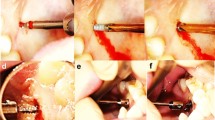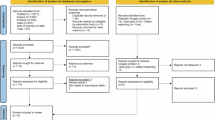Abstract
Data sources
Medline, Cochrane Central Register of Controlled Trials (CENTRAL), Embase, China National Knowledge Infrastructure (CNKI) and SIGLE.
Study selection
Randomised controlled trials(RCTs), clinical controlled trials (CCTs) and cohort studies that assessed the success/failure rates of self-drilling and self-tapping mini-screws for orthodontic anchorage were considered.
Data extraction and synthesis
Data was abstracted and assessed for quality by two reviewers independently. The Newcastle-Ottawa scale (NOS) was used to evaluate the methodological quality. Meta-analyses with subgroup analysis of different study designs, follow-up periods, participant age and immediate loading or delayed loading were conducted.
Results
Three CCTs and three cohort studies were included. These were assessed to be of high quality. Meta-analysis (six studies) showed no difference in success rates between the two types of screws; odds ratio (OR) = 0.90 (95%CI; 0.52-1.53). Meta-analysis (two studies) found no difference in the rate of root contact between the two systems; OR = 0.96 (95% CI; 0.53-1.71).
Conclusions
Currently available clinical evidence suggests that the success rates of self-tapping and self-drilling miniscrews are similar. Determination of the position and direction of placement should be more precise when self-drilling miniscrews are used in sites with narrow root proximity.
Similar content being viewed by others
Log in or create a free account to read this content
Gain free access to this article, as well as selected content from this journal and more on nature.com
or
References
Yi J, Ge M, Li M, Li C, Li Y, Li X, Zhao Z . Comparison of the success rate between self-drilling and self-tapping miniscrews: a systematic review and meta-analysis. Eur J Orthod 2016; pii: cjw036. [Epub ahead of print].
Shea BJ, Grimshaw JM, Wells GA, et al. Development of AMSTAR: a measurement tool to assess the methodological quality of systematic reviews. BMC Med Res Methodol 2007; 7: 10.
Shea BJ, Hamel C, Wells GA, et al. AMSTAR is a reliable and valid measurement tool to assess the methodological quality of systematic reviews. J Clin Epidemiol 2009; 62: 1013–1020.
Risk of bias in systematic reviews (ROBIS). ROBIS tool and the ROBIS guidance document. [online] Available from: http://www.robis-tool.info/ [Accessed 13 August 2016]
Whiting P, Savović J, Higgins JP, et al; ROBIS group. ROBIS: A new tool to assess risk of bias in systematic reviews was developed. J Clin Epidemiol 2016; 69: 225–234.
O'Connor D, Green S . Higgins JPT (editors). Chapter 5: Defining the review question and developing criteria for including studies. In: Higgins JPT, Green S (editors). Cochrane Handbook for Systematic Reviews of Interventions Version 5.1.0 (updated March 2011). The Cochrane Collaboration, 2011. [online] Available from: www.cochrane-handbook.org. [Accessed 18 August 2016].
Methodological Expectations of Cochrane Intervention Reviews (MECIR). The methodological standards for the conduct of new Cochrane Intervention Reviews (Version 2.3 02 December 2013). [online] Available from: http://editorial-unit.cochrane.org/sites/editorial-unit.cochrane.org/files/uploads/MECIR_conduct_standards%202.3%2002122013_0.pdf [Accessed 19 August 2016].
Meursinge Reynders R, Ladu L, Ronchi L, et al. Insertion torque recordings for the diagnosis of contact between orthodontic mini-implants and dental roots: a systematic review. Syst Rev 2016; 5: 50.
PROSPERO: Centre for Reviews and Dissemination. University of York, UK. [online] Available from: [http://www.crd.york.ac.uk/PROSPERO/] [Accessed 16 August 2016].
Enabling Open Scholarship (EOS). [online] Available from: http://www.openscholarship.org/upload/docs/application/pdf/200909/open_access_institutional_repositories.pdf [Accessed 14 August 2016].
The directory of Open Access Repositories (Open DOAR). [online] Available from: http://www.opendoar.org/ [Accessed 14 August 2016].
Registry of Open Access Repositories (ROAR). [online] Available from: http://roar.eprints.org/ [Accessed 14 August 2016].
International Clinical Trials Registry Platform of the World Health Organization (ICTRP). [online] Available from: http://apps.who.int/trialsearch/AdvSearch.aspx [Accessed 14 August 2016].
Kirkham JJ, Dwan KM, Altman DG, et al. The impact of outcome reporting bias in randomised controlled trials on a cohort of systematic reviews. Br Med J 2010; 340: c365.
Moher D, Liberati A, Tetzlaff J . Altman DG ; PRISMA Group. Preferred reporting items for systematic reviews and meta-analyses: the PRISMA statement. PLoS Med. 2009; 6: e1000097.
Wells GA, Shea B, O'Connell D, Peterson J, Welch V, Losos M, Tugwell P . The Newcastle-Ottawa Scale (NOS) for assessing the quality of nonrandomised studies in meta-analyses. [online] Available from: http://www.ohri.ca/programs/clinical_epidemiology/oxford.asp [Accessed 10 August 2016].
Sanderson S, Tatt ID, Higgins JP . Tools for assessing quality and susceptibility to bias in observational studies in epidemiology: a systematic review and annotated bibliography. Int J Epidemiol 2007; 36:666–676.
Hartling L, Hamm M, Milne A, Vandermeer B, Santaguida PL, Ansari M, Tsertsvadze A, Hempel S, Shekelle P, Dryden DM . Validity and inter-rater reliability testing of quality assessment instruments. (Prepared by the University of Alberta Evidence-based Practice Center under Contract No. 290-2007-10021-I.) AHRQ Publication No. 12-EHC039-EF. Rockville, MD: Agency for Healthcare Research and Quality. March 2012. [online] Available from: www.effectivehealthcare.ahrq.gov/reports/final.cfm [Accessed 14 August 2016].
Hartling L, Hamm MP, Milne A, et al. Testing the risk of bias tool showed low reliability between individual reviewers and across consensus assessments of reviewer pairs. J Clin Epidemiol 2013; 66: 973–981.
Hartling L, Milne A, Hamm MP, et al. Testing the Newcastle Ottawa Scale showed low reliability between individual reviewers. J Clin Epidemiol 2013; 66: 982–993.
Lo CK, Mertz D, Loeb M . Newcastle-Ottawa Scale: comparing reviewers' to authors' assessments. BMC Med Res Methodol 2014; 14:45.
Risk of Bias in Non-randomized Studies-of Interventions (ROBINS-I) tool. [online] Available from: https://sites.google.com/site/riskofbiastool/ [Accessed 15 August 2016].
Sterne JAC, Higgins JPT . Reeves BC on behalf of the development group for ACROBAT-NRSI. A Cochrane Risk Of Bias Assessment Tool: for Non-Randomized Studies of Interventions (ACROBAT-NRSI), Version 1.0.0, 24 September 2014. [online] Available from: http://www.riskofbias.info [Accessed 26 November 2016].
The Nordic Cochrane Centre. Review Manager (RevMan) [Computer program]: version 5.3. Copenhagen: the Nordic Cochrane Centre, The Cochrane Collaboration; 2014.
Borenstein M, Hedges LV, Higgins JPT . Rothstein HR: Chapter 40: When does it make sense to perform a meta-analysis? In Introduction to Meta-Analysis. Edited by Borenstein M, Hedges LV, Higgins JPT, Rothstein HR. Chichester (UK): John Wiley & Sons; 2009.
Deeks JJ, Higgins JPT, Altman DG . Chapter 9: Analysing data and undertaking meta-analyses. In: Higgins JPT, Green S (editors), Cochrane Handbook for Systematic Reviews of Interventions Version 5.1.0 (updated March 2011). The Cochrane Collaboration, 2011. [online] Available from: www.cochrane-handbook.org. [Accessed 16 August 2016].
Borenstein M, Hedges LV, Higgins JPT, Rothstein HR . Chapter 13: Fixed-effect versus random-effects models. In: Borenstein M, Hedges LV, Higgins JPT, Rothstein HR, (editors). Introduction to meta-analysis. Chichester (UK): John Wiley & Sons; 2009.
Higgins JP, Thompson SG, Deeks JJ, Altman DG . Measuring inconsistency in meta-analyses. Br Med. J 2003; 327: 557–560.
Author information
Authors and Affiliations
Additional information
Address for correspondence: Zhihe Zhao, Department of Orthodontics, State Key Laboratory of Oral Diseases, West China Hospital of Stomatology, Sichuan University, #14, 3rd Section, South Renmin Road, Chengdu 610041, PR China. E-mail: zhzhao@scu.edu.cn
Yi J, Ge M, Li M, Li C, Li Y, Li X, Zhao Z. Comparison of the success rate between self-drilling and self-tapping miniscrews: a systematic review and meta-analysis. Eur J Orthod 2016; pii: cjw036. [Epub ahead of print] Review. PubMed PMID: 27166073.
Rights and permissions
About this article
Cite this article
Reynders, R., Cacciatore, G. No confidence that success rates of self-drilling and self-tapping insertion techniques of orthodontic mini-implants are similar. Evid Based Dent 17, 111–113 (2016). https://doi.org/10.1038/sj.ebd.6401203
Published:
Issue date:
DOI: https://doi.org/10.1038/sj.ebd.6401203



